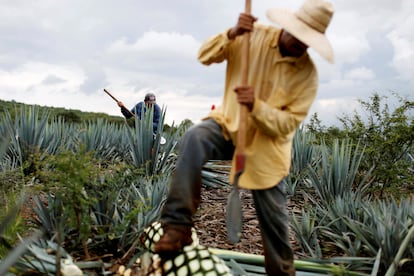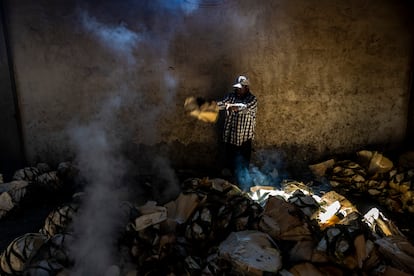California, the new frontier for the Mexican agave plant
Faced with drought and extreme heat, US scientists and producers are studying the potential for this tequila and mezcal plant in the state

Jalisco is known as the tequila capital. Oaxaca is known as the mezcal capital. But the two Mexican cities may have a serious contender for these titles in the future as scientists in California experiment with the plant from which the distilled spirit is made. Their aim? To determine its viability in the state’s arid terrain that has suffered from high temperatures and a devastating drought since 2016. Not surprisingly, some producers consider agave to be a crop with enormous potential in the sunshine state’s increasingly extreme climate.
In late May, around 40 farmers gathered at the first agave conference in California, organized by the California University Davis, which specializes in agriculture. One of the most enthusiastic attendees was Stuart Woolf, a veteran farmer from the state’s Central Valley. His enterprise has produced tomatoes, pistachios and almonds for years, crops that are as popular as they are profitable in the Californian countryside. A pound of nuts can sell for $4 or $5. Some time ago, however, Woolf planted some 900 agave plants on just over half an acre of land. During the conference, he posed a question, “Can we grow more plants per hectare than Mexico?”
The answer to the question is being sought in laboratories. “The rainfall patterns and growing conditions in California are different from those in the area where tequila is made,” said Ron Runnebaum, professor of Viticulture and Enology at UC Davis who organized the conference. “It is exciting to begin to study the possibilities and determine what types of agave varieties can be grown commercially in California and what flavors can be enhanced during distillation to make agave drinks unique to the state.”
The conference launched the California Agave Council. Stuart Woolf and his wife Lisa donated $100,000 to a fund to encourage agave studies on US soil. Woolf believes that Californian soil can produce agave with higher sugar concentrations, which would produce more alcohol by volume. It is, however, a complicated crop because its cycle lasts between five and eight years. And it takes about seven kilos of agave to produce one liter of tequila. After harvesting it, more must be planted. These pioneers of this fledgling agricultural initiative say it’s not something that can happen overnight. So far, there are barely 16 hectares of agave cultivated in the vast Californian terrain.

The Californian countryside produces 400 different crops. One third of all vegetables consumed in the US come from here. The proportion is even higher when talking about almonds, pistachios, walnuts, and a range of fruits – which account for two thirds of US fruit consumption. The almond market alone, the second largest after milk, is worth $5.6 billion, according to official 2020 figures. Meanwhile, California’s Napa Valley is synonymous with US wine. Can the state now also be associated with agave?
Tequila and mezcal are protected in Mexico by appellation of origin. Tequila has five production territories, while mezcal is produced in nine states, where it assumes different names. Experts point out that all tequila is, in fact, mezcal, but not all mezcal is tequila. Tequila is made from only one of more than 200 varieties of agave: the Blue Webber Agave. It is estimated that 85% of agave in Mexico is of this variety. The National Chamber of Industry in Mexico points out that one of the advantages of this plant is that it does not require irrigation – music to the ears of California growers, who have seen their crops suffer in areas that have been declared by the State Department of Agriculture to have “extreme” and “exceptional” levels of drought.
In his book. The Dreamt land: Chasing water and Dust across California, journalist Greg Arax explains how the richness of California’s countryside is due to its water system. One-third of the water that irrigates California’s
agriculture comes from the Sacramento River and its tributaries. There is another source in the San Joaquin Valley, which carries far less volume. But a vast network of wells drawing on reservoirs from the Kern, Kings and San Joaquin rivers allow extensive crops to be irrigated. As Arax says, “California’s unhappiness is in its soil, but its solution is in its water.”
Water in the state is becoming increasingly scarce, forcing farmers – many of whom have seen their water allocation for irrigation drastically reduced – to look for alternative crops such as chickpeas, which have become more common here in recent years. Calculations by Davis academics indicate that agave could survive in California with less than eight centimeters of water per hectare. This contrasts with the growing of almonds, which need more than 240 centimeters of water per hectare.
The ambition of the producers’ group coincides with a boom in demand for tequila and mezcal. The pandemic boosted consumption of both spirits worldwide and Mexico exported record amounts in 2020. The National Chamber of Industry noted that this demand was maintained into 2021, when tequila production grew by a further 40%, to a never-before-seen output of 527 million liters. The fastest growing segment is 100% agave tequila, which is thriving in the luxury market.
Laura Alcocer, a PhD student at the University of Davis, recently addressed one of the contradictions in the industry in Mexico. Tequila production has soared 50% in the last five years to meet growing demand. But the actual growing of agave has fallen 20% from its peak in 2014. “To maintain the increase in tequila production, agave production will have to be increased again,” she pointed out last November. Last year did see a rise in production; in just 20 years, the tequila agave went from being grown only in Jalisco to being grown in eight other Mexican states. Going forward, will California be a new frontier to conquer?
Tu suscripción se está usando en otro dispositivo
¿Quieres añadir otro usuario a tu suscripción?
Si continúas leyendo en este dispositivo, no se podrá leer en el otro.
FlechaTu suscripción se está usando en otro dispositivo y solo puedes acceder a EL PAÍS desde un dispositivo a la vez.
Si quieres compartir tu cuenta, cambia tu suscripción a la modalidad Premium, así podrás añadir otro usuario. Cada uno accederá con su propia cuenta de email, lo que os permitirá personalizar vuestra experiencia en EL PAÍS.
¿Tienes una suscripción de empresa? Accede aquí para contratar más cuentas.
En el caso de no saber quién está usando tu cuenta, te recomendamos cambiar tu contraseña aquí.
Si decides continuar compartiendo tu cuenta, este mensaje se mostrará en tu dispositivo y en el de la otra persona que está usando tu cuenta de forma indefinida, afectando a tu experiencia de lectura. Puedes consultar aquí los términos y condiciones de la suscripción digital.
More information
Últimas noticias
Maduro pleads not guilty before the federal court in New York: ‘I am still the president of Venezuela’
A new test can detect Alzheimer’s from a finger prick
UN team enters Sudanese city of El Fasher after paramilitary massacre: ‘It’s like a ghost town’
A recipe for resistance: Indigenous peoples politicize their struggles from the kitchen
Most viewed
- Gilles Lipovetsky: ‘If you want to live better and fall in love, take Prozac, don’t look to philosophy’
- Alain Aspect, Nobel laureate in physics: ‘Einstein was so smart that he would have had to recognize quantum entanglement’
- Alvin Hellerstein, a 92-year-old judge appointed by Bill Clinton, to preside over Maduro’s trial in New York
- Why oil has been at the center of Venezuela-US conflicts for decades
- Maduro’s downfall puts China’s relationship with Venezuela to the test











































